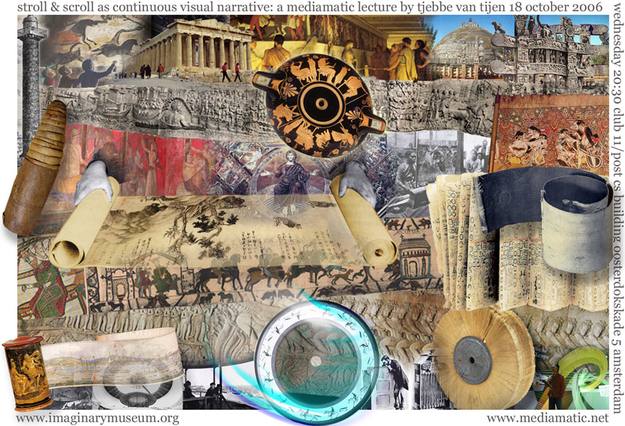story telling
Strolling & Scrolling are two ways of animating a continuous series of signs and pictures into a story. It is either the spectator that moves along the images or the other way around: a pilgrim walking and 'reading' for days along the friezes of temples; be it Angkor Watt in Cambodia, or the Borobudur in Java. The faithful reading bible stories from the frescoes on the walls and ceilings of European churches. An Asiatic scholar unrolling a scroll with one hand and rolling it with the other, thus bringing into view a shifting poetic landscape of pictures and signs. The narrator of the Indonesian Wayang Beber, who shows, sings and tells a painting on a roll to his audience.
A congregation of citizens of the French town of Bayeux witnessing in their church the yearly unrolling of seventy meters of embroidered tapestry depicting a historical battle.
Visual narrative media stem from stories, and, are also memory devices that keep these stories alive. Some of them need a mediator: a shaman, priest, dalang, bhopo, benshi, Bänkelsänger, cantastorie, or other story singers and tellers, narrators and explicators. The original meaning of certain visual narratives may have been lost, though there are attempts to reconstruct something of their original message. Apart from that, there is always the personal and independent eye and mind of the beholder. Most tourists who visit temples, churches and other sacral sites, will use their own intuition, make up their own stories while taking in a 'visual narrative'.
Reversing our historical perspective on visual and narrative media, looking back from the present day digital immersive environment, the CAVE (Cave Automatic Virtual Environment), to the natural underground void of our forebears, one can discover conceptual analogies: the potter wheel and cinematic animation; paper scrolls and the panning movement in movies; harmonica-like book pages and mechanical reproduction of sound; the reflection in water and optical devices of magic mirror, anamorphosis and camera obscura...
The visual lecture by Tjebbe van Tijen made an attempt to give a concise overview of all these associations, linkages and some of the entertaining side stories that accompanied them.
Check out this website for more information.
